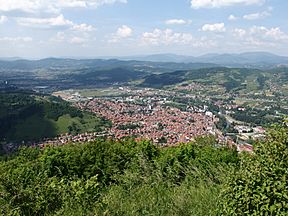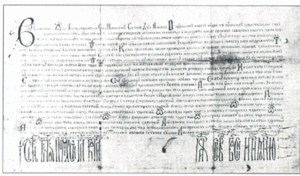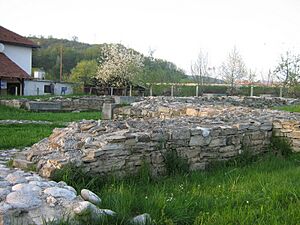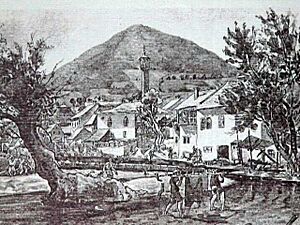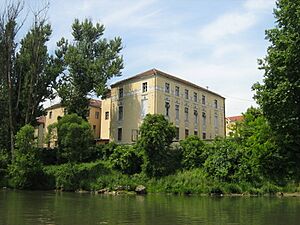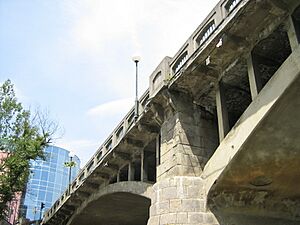Visoko facts for kids
Quick facts for kids
Visoko
Високо
|
||
|---|---|---|
| Grad Visoko Град Високо City of Visoko |
||
|
Top to bottom, left to right: View from Visočica hill, Tabačka mosque, Church of St. Procopius, Franciscan monastery of St. Bonaventure, Old town of Visoki, Fojnička River at the confluence with River Bosna, View from Vrela hill
|
||
|
||
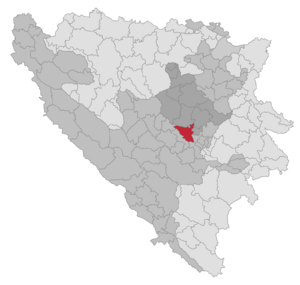
Location of municipality within Bosnia and Herzegovina
|
||
| Country | ||
| Entity | Federation of Bosnia and Herzegovina | |
| Canton | ||
| Area | ||
| • City | 230.8 km2 (89.1 sq mi) | |
| Population
(2013)
|
||
| • City | 39,938 | |
| • Density | 80/km2 (206/sq mi) | |
| • Urban | 11,205 | |
| Time zone | UTC+1 (CET) | |
| • Summer (DST) | UTC+2 (CEST) | |
| Postal code |
71300
|
|
| Area code(s) | +387 32 | |
Visoko (Serbian Cyrillic: Високо) is a city in Bosnia and Herzegovina. It is part of the Zenica-Doboj Canton in the Federation of Bosnia and Herzegovina. In 2013, about 40,000 people lived in the whole area, with over 11,000 in Visoko town itself.
Visoko is located between the cities of Zenica and Sarajevo. It sits where the Fojnička River joins the larger Bosna River. The area around Visoko has been lived in for a very long time. The first signs of people here date back to 5,000 BC.
Visoko was an important place in the Bosnian medieval state. It was a center for politics and trade. The first Bosnian king, Tvrtko I, was crowned here. The Old town of Visoki fortress was very important. After the Kingdom of Bosnia fell, Visoko grew into an Ottoman town.
Ottoman rule ended in 1878 when Austria-Hungary took over. In 1911, a big fire almost destroyed the town. Before the Bosnian War, Visoko was known for making textiles and leather. Today, Visoko attracts many visitors, especially because of the Bosnian pyramid claims.
Contents
Exploring Visoko's Geography
Visoko is located in a beautiful area of Bosnia. The municipality covers about 232 square kilometers. It has many valleys formed by hills and mountains like Ozren and Zvijezda. The land here is between 400 and 1,050 meters above sea level.
The two main rivers, Bosna and Fojnica, shape the natural environment. Visoko is connected by train to the Adriatic Sea. It also has good road connections to nearby cities like Zenica and Sarajevo.
Getting Around Visoko
Visoko is well-connected by roads and railways. The A1 motorway (part of European route E73) links it directly to Zenica and Sarajevo. There is also a regional road, R443, that connects Visoko to other towns.
The town is on the Šamac-Sarajevo railway line. Visokogas is a company that supplies natural gas to the city.
Who Lives in Visoko?
The population of Visoko has changed over the years. In 2013, the total population was 39,938 people. Most residents are Bosniaks, making up about 91.88% of the population. There are also smaller groups of Croats and Serbs.
In 1991, before the war, the population was larger, around 46,160. The number of Bosniaks has increased, while the numbers of Serbs and Croats have decreased since then.
A Look at Visoko's History
Visoko has a very long and interesting history. People have lived here for thousands of years.
Life in Prehistoric Times
The Visoko area has been home to people since the Stone Age. The Bosna and Fojnica rivers made the land fertile for farming. This made the Visoko basin a great place for early settlements.
Archaeologists have found large Neolithic settlements here. One of the biggest is Okolište. It was part of the Butmir culture and may have had around 3,000 people living there. This settlement is about 4,700 to 4,500 years old.
Ancient Illyrians and Romans
The Illyrian tribe called Daesitiates lived in the Visoko area. They were part of the Bronze Age and Iron Age cultures. The Roman empire took control around 9 AD. They built roads and forts in the region. Visoko was part of the Roman province of Illyricum.
Visoko in the Middle Ages (958–1463)
After the Roman Empire, new people called Slavs came to the Balkans. The local Illyrian tribes slowly became Slavic. The name of the river Bosna comes from this time. The Visoko basin is thought to be where the medieval Bosnian state began around 1000 AD.
Visoko is named after the Visoki Castle on Visočica hill. The areas of Podvisoki, Mile, Biskupići, and Moštre were the early heart of the medieval Bosnian kingdom. Many important documents were signed here. The town of Visoki protected Podvisoki, which was a major trade center.
The Rusag (a council of nobles) met at Mile. King Tvrtko I was crowned there in 1377 and was later buried there. Mile is known for its many old tombs of kings and rulers. At Biskupići, archaeologists found Ban Kulin's Plate from 1193. Moštre had a university known for its studies in medicine and other subjects.
Ottoman Rule (1463–1878)
The Ottoman Empire took over Visoko around 1463. Modern Visoko began to form during this time. A local man named Ajas-beg (later Ajas-pasha) was important in its development. He built a bathhouse (hammam), a school (mekteb), an aqueduct, a bridge over the Bosna river, and an Islamic high school (madrassa). He also founded a Dervish monastery (tekke).
Visoko quickly became an important center for administration, trade, and culture. It took on the look of an Islamic-style town with many religious buildings.
Austro-Hungarian Period (1878–1918)
Austria-Hungary occupied Bosnia in 1878. At first, Visoko kept its oriental look. But soon, new buildings started to appear in a Pseudo-Moorish style. These included the train station (1882), the court building (1895), and a church with a gymnasium (1899–1900).
In 1911, a large fire, called jangija, burned down most of the upper city. About 450 homes and shops were destroyed. When the city was rebuilt in 1912, the government decided that new houses should be made of bricks with tile roofs in a traditional Bosnian style. This gave Visoko a unique mix of Eastern and Western styles.
Yugoslavia and World War II (1918–1945)
After World War I, Visoko became part of the new Kingdom of Yugoslavia. The town did not change much during this time. During World War II, Visoko was part of the Independent State of Croatia. The town was not a major battleground and did not suffer much damage from fighting. However, many soldiers from the Visoko area were killed. Visoko was freed on April 7, 1945.
Socialist Yugoslavia (1945–1992)
After World War II, Visoko grew a lot and became more industrial. The town expanded along the Bosna and Fojnica rivers. Visoko was famous for its leather industry. KTK, the biggest leather company in Yugoslavia, was based here. Visoko also had strong textile, metal, and food industries. It became one of the largest exporters in Socialist Yugoslavia.
During this time, Visoko built many important facilities like a post office, police and fire stations, hospitals, hotels, and sports stadiums. Culture also grew with a theater, museum, cinema, and library. New schools were built, including a primary school and two high schools.
Bosnian War (1992–1995)
In April 1992, the Bosnian War began. Local forces quickly took control of two army barracks, getting weapons to defend the town. Visoko was important for the Army of Bosnia & Herzegovina (ARBiH). It served as a center for refugees and a supply hub because of its industries and an improvised airfield.
The town was heavily damaged during the war. Factories and other economic resources were destroyed. The damage to the economy was estimated at $200 million. Many soldiers from Visoko were killed or wounded. After four years, the Dayton agreement ended the war.
Bosnian Pyramid Claims
Visočica hill is a hill near Visoko. In 2005, a Bosnian author named Semir Osmanagić claimed that this hill and others nearby were actually ancient pyramids.
However, scientific studies of the site have shown that there are no pyramids. Scientists have said that these claims are not based on real science. Bosnian archaeologists have asked the government to focus on protecting the medieval town instead.
Visoko's Economy
Visoko had a strong economy during the socialist era. It exported over $1 million worth of goods in 1991. The leather and textile industries were very important, led by companies like KTK and Vitex.
The Bosnian War destroyed much of Visoko's industry. However, even during the war, factories continued to produce goods for the army and people.
Today, the leather industry is still important. A company called Prevent employs many workers and makes products for the European automobile industry. The food company Vispak made the world's largest coffee pot in 2005, earning a Guinness certificate.
Visoko is also known for its dried meat products, especially "Visočka pečenica." This is a special type of dried beef. An association of meat processors is working to protect "Visočka pečenica" as a unique brand.
Tourism in Visoko
Since 2006, many tourists have visited Visoko because of the Semir Osmanagić's Bosnian pyramid claims. The city has invested money to support tourism.
Learning in Visoko
There are mentions of medieval universities in the Visoko area. One was a high academy of the Bosnian religious organization, known for studying medicine, theology, and ethics.
Modern education began with Ottoman schools in the 1870s. Later, Austro-Hungarian authorities built the first proper school in 1910, which is still standing. A Franciscan gymnasium (high school) moved to Visoko in 1900. Because leather was so important, a "Leather school" was created in 1929.
Culture and Society in Visoko
Visoko has a rich cultural heritage.
Important Buildings and Monuments
There are six National Monuments of Bosnia and Herzegovina in Visoko:
- Mile: A place where medieval Bosnian nobles gathered.
- Neolithic settlement in Okolište: The largest site of the Butmir culture.
- Old town of Visoki: A fortress above modern Visoko.
- The Orthodox Church of St Procopius of Scythopolis.
- The Franciscan monastery of Saint Bonaventure.
- The Tabačka (Tabačica) mosque.
Šerefudin's White Mosque is also very important for its unique design. It won the Aga Khan Award for Architecture in 1983.
Museums to Visit
Visoko has a homeland museum. It shows the history and culture of the Visoko area and Bosnia. Many exhibits are about the medieval Bosnian state, as Visoko was a key center for Bosnian kings. There is also an extension of the museum in Goduša, showing old woodcarving crafts.
Music and Tradition
In nearby Mulići, there is the Sevdah Institute of Omer Pobrić. Its goal is to protect Bosniak music, especially sevdalinka, which is a traditional Bosnian folk song.
Sports in Visoko

Organized sports started in Visoko with the opening of schools. The Soko society, formed in 1909, supported many sports. A sports center built in 1934 allowed people to play volleyball, football, and handball.
The handball club RK Bosna Visoko has won the Handball Championship of Bosnia and Herzegovina twice (1997, 1999) and the Handball Cup of Bosnia and Herzegovina twice (1998, 2001). They even reached the Eight-finals of the EHF Cup in 1999–2000.
The football club NK Bosna Visoko won the Bosnia and Herzegovina Football Cup and the Supercup of Bosnia and Herzegovina in 1999. The "Izet Kurtalić" Aero club, formed in 1960, has won many awards in model aircraft competitions.
Visoko also hosted qualifiers for the Futsal World Cup 2008 in its Mladost hall.
| Club | Leagues | Venue | Established |
|---|---|---|---|
| RK Bosna Visoko | Premier handball league | Hall "Mladost" | 1953 |
| NK Bosna Visoko | Second League of the Federation of Bosnia and Herzegovina | Luke Stadium | 1923 (Jadran), 1934 (Radnički); Merged in 1953 |
Famous People from Visoko
- Adnan Mević: He was officially named the 6 billionth person born on Earth by the United Nations.
- Ajas-pasha: A Bosniak Ottoman leader who helped develop Visoko.
- Matrakçı Nasuh: A famous 16th-century Bosniak Ottoman mathematician and artist.
- Mustafa Cerić: A former Grand Mufti (religious leader) of Bosnia and Herzegovina.
- Zaim Muzaferija: A well-known actor.
- Slaviša Vukićević: A football player.
- Haris Mujezinović: A basketball player.
- Elvedina Muzaferija: An alpine skier.
- Enes Begović: A singer-songwriter.
- Ognjen Prica: A National Hero of Yugoslavia who spent his childhood in Visoko.
Sister Cities
Visoko is twinned with these cities:
Images for kids
See also
 In Spanish: Visoko para niños
In Spanish: Visoko para niños


